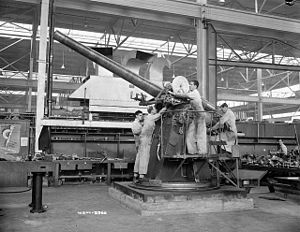|
Cannon 102/45
The Cannon 102/45 was a naval gun of the Italian Navy in World War II, which was later modified for shore based anti-aircraft and coastal artillery roles. HistoryDuring World War I the United Kingdom delivered a QF 4 inch Mk V naval gun, serial No.974 to Italy to act as a template for licensed production by the Ansaldo Company. The Mark V was constructed of a tapered inner A tube, A tube, taper wound wire, full-length jacket and breech ring.[2] It had either a horizontal or vertical sliding breech block, with semi-automatic action and used fixed quick-fire ammunition. There were three models produced: Schneider-Armstrong Model 1917, Schneider-Armstrong Model 1919, and Schneider-Canet Model 1917; each with differing mounts and elevations. Overall the 102/45 was considered a successful design and it was widely used on destroyers of the Italian Navy before and during World War II. The exception being the Schneider-Armstrong Model 1919 which was an unsatisfactory twin mount with both guns sharing a common cradle. The Model 1919 was later replaced by single mounts during the war.[3] The 102/45 was in the process of being replaced by the Cannon 120/45 and 120/50 when World War II began. Starting in 1937 guns that were removed from ships were mounted on new dual-purpose shore mounts and used as anti-aircraft guns and coastal artillery until retired in 1945. Interesting facts
Types
Notes
Bibliography
|
||||||||||||||||||||||||||||||||||||||||||||||||||||||||||||||||||||||||||||
